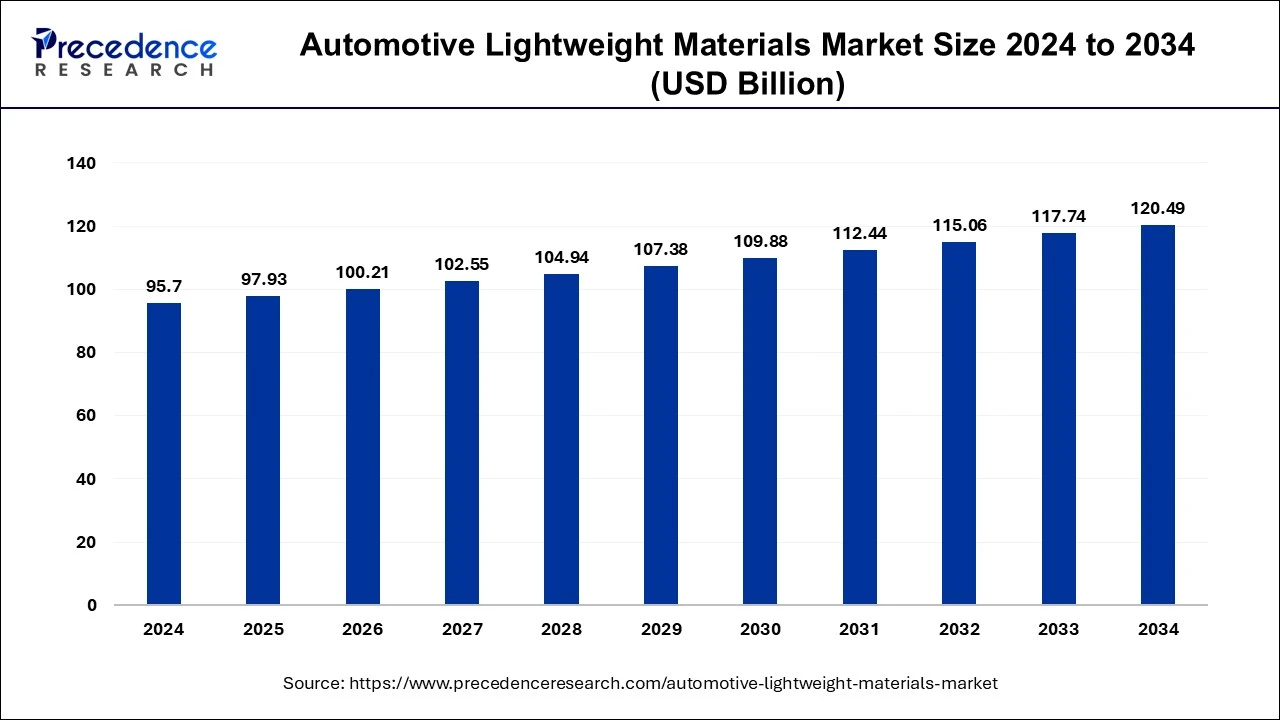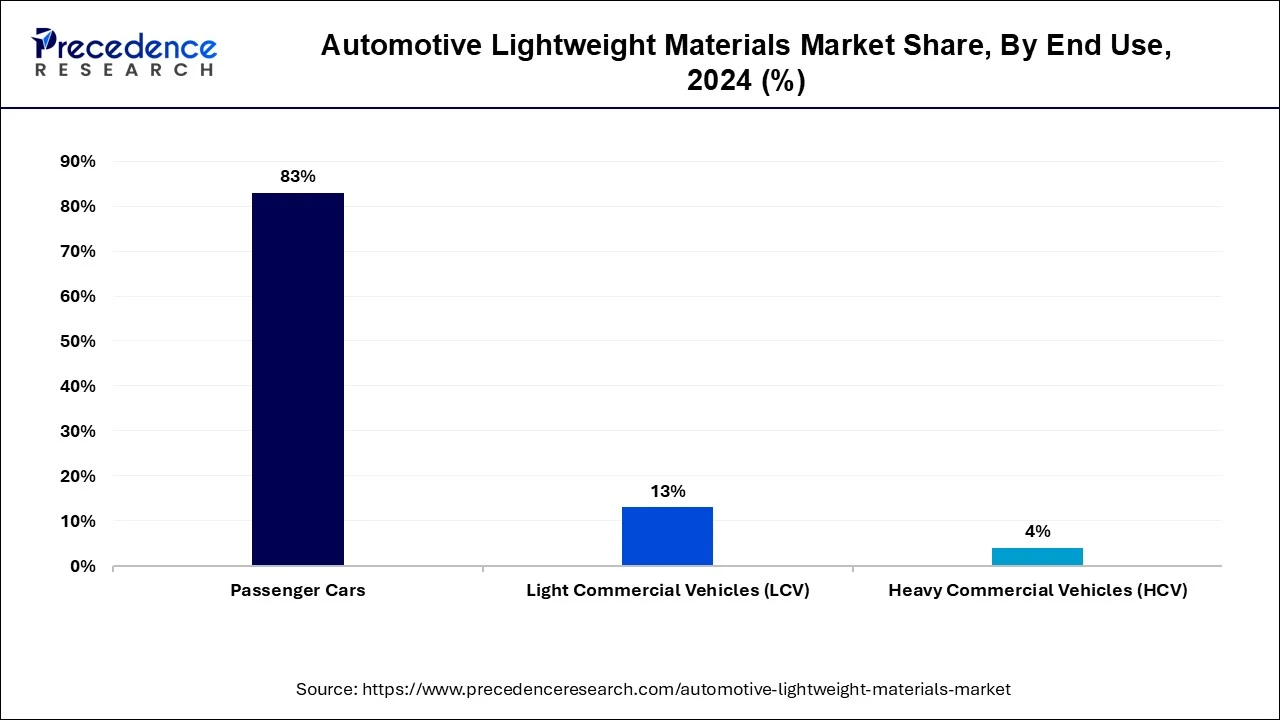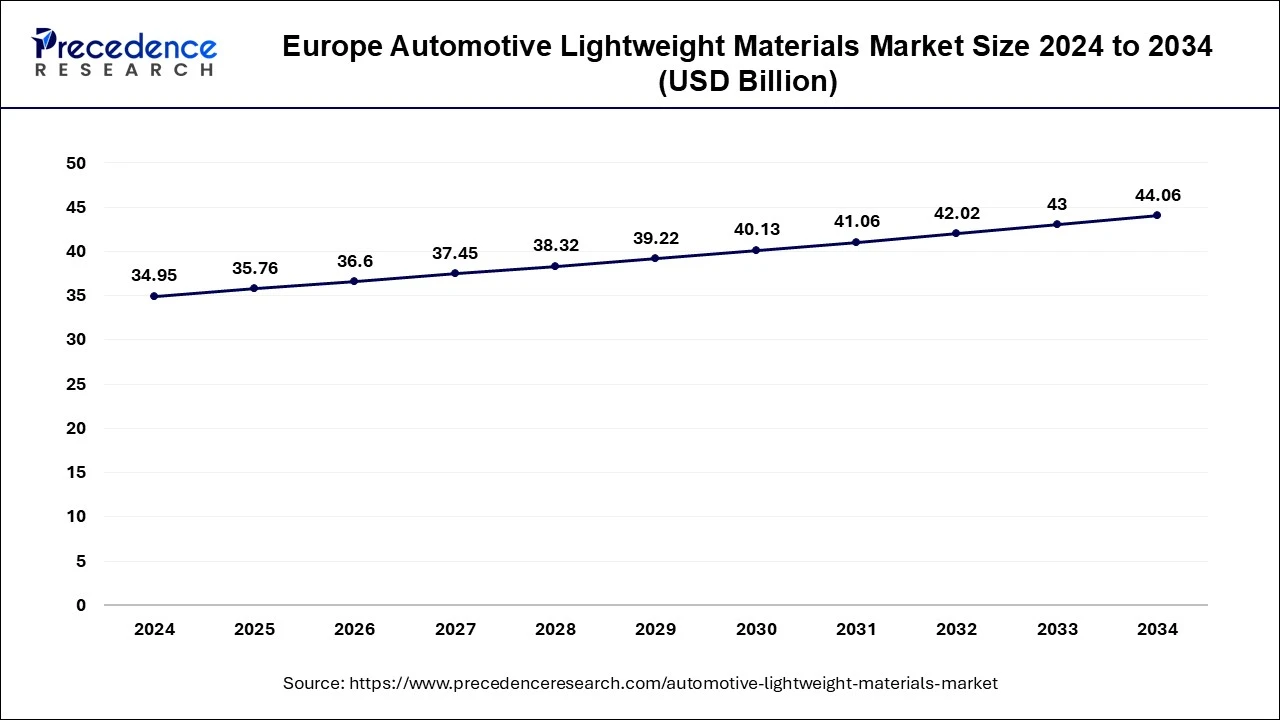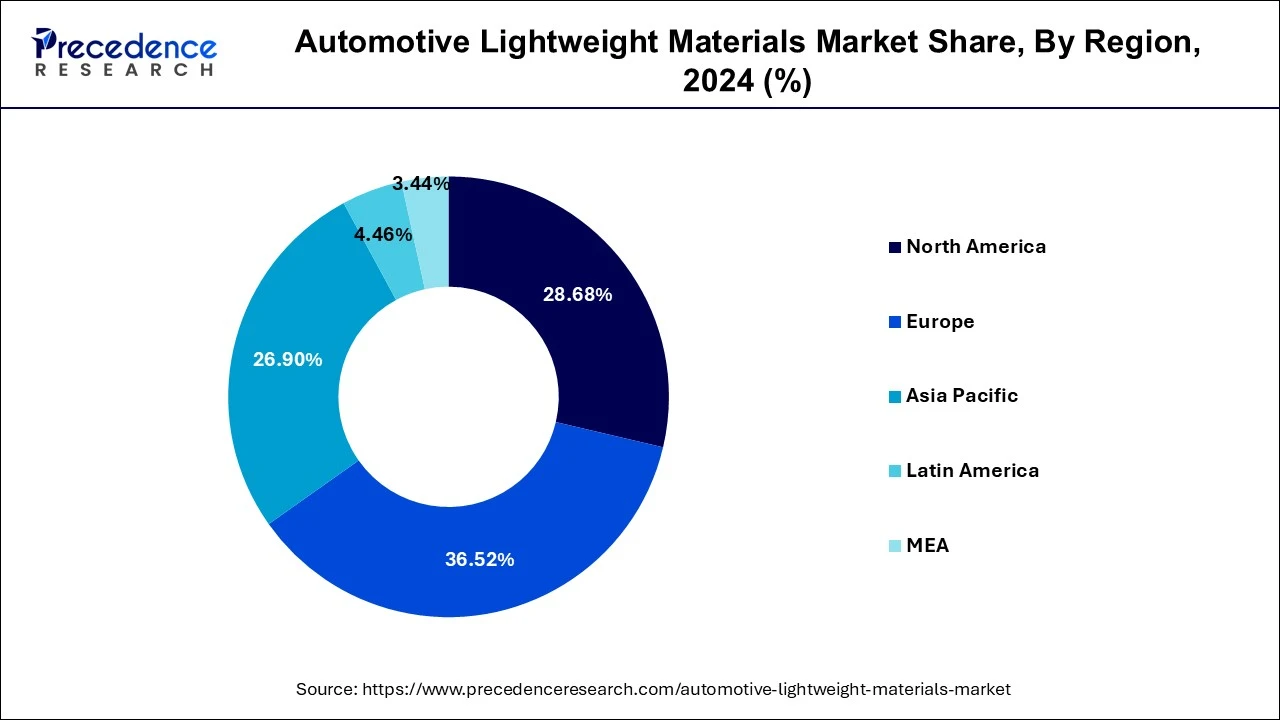List of Contents
What is the Automotive Lightweight Materials Market Size?
The global automotive lightweight materials market size is accounted at USD 97.93 billion in 2025 and predicted to increase from USD 100.21 billion in 2026 to approximately USD 120.49 billion by 2034, expanding at a CAGR of 2.33% from 2025 to 2034. There is a growing demand for automative lightweight materials market as the sector needs materials that can increase fuel efficiency of the vehicles.

Automotive Lightweight Materials Market Key Takeaways
- Europe dominated the global automotive lightweight market with the largest market share of 36.52% in 2024.
- Germany automotive lightweight materials market is registering a notable CAGR of 6.99% over the forecast period.
- North America is expected to expand at a solid CAGR of 4.96% during the forecast period.
- By material, the composites segment contributed the highest market share of 66% in 2024.
- By material, the plastics segment is projected to grow at a CAGR of 3.83% during the forecast period.
- By application, the body in white (BiW) segment accounted for the highest market share of 26% in 2024.
- By application, the closures segment is expected to grow at a CAGR of 2.6% during the forecast period.
- By end use, the passenger cars segment has held a major market share of 83% in 2024.
- By end use, the LCVs segment is expanding at a CAGR of 3.3% during the forecast period.
Feathering the Future: Automotive Lightweight Materials
Automotive lightweight materials market is growing because there is a necessity for vehicles that are lighter and more fuel efficient. Lightweight materials can help manufacturers optimize their production process with these advanced materials which reduces manufacturing costs. Some of these materials may be slightly expensive, but there have proven to be beneficial in the long run. The automakers need to accommodate costs pressures, making investments in lightweight materials can benefit in fuel consumption and maintenance of a vehicle during its lifecycle. These materials go a long way in improving fuel efficiency of car and also, reduce operational costs.
With new developments like the Electric Vehicles (EVs), there is a necessity for efficient energy use which will maximize battery life and improve range; the weight of the vehicle becomes a crucial aspect. Lightweight materials like carbon fibers, aluminum, high strength steel etc. are being widely used in making EVs. Lightweight materials help in bettering vehicle dynamics, acceleration, and handling while maintaining structural foundation during mishaps. Lightweight materials for manufacturers are a way to meet evolving consumer demands as these improve performance as well as safety of a vehicle which will aid market growth of the automotive lightweight materials market.
The automotive lightweight materials market is accelerating as OEMs and suppliers race to shave vehicle mass to meet regulatory fuel-efficiency targets, electrification range goals, and customer expectations for performance. This market covers metals, high-strength steels, aluminum, magnesium, polymers and composites, glass-fibre and carbon-fibre reinforced polymers, advanced hybrid metal-polymer laminates, and emerging materials such as thermoplastic composites and metal-matrix composites.
Demand is driven by a combination of stricter emissions regulations, the rapid rise of electric vehicles, where weight reduction directly extends range, and consumer preference for better handling and efficiency. Lightweighting strategies are becoming more sophisticated, moving from single-part substitutions to system-level design optimizations that combine material science, structural engineering, and manufacturing innovations such as additive manufacturing and advanced joining techniques.
Market Outlook
- Industry Growth Overview: The industry spans raw-material suppliers, material processors, tier-1 system integrators, OEMs, and specialized engineering firms. Raw-material producers develop alloys, fibres, and polymers; processors convert these into sheets, extrusions, preforms, or composite layups; tier-1s design and assemble structural systems; and OEMs integrate lightweighting into platform architecture and vehicle-level trade-offs.
- Crucial enabling capabilities include advanced material characterization, predictive simulation for crash and fatigue behaviour, joining technologies, adhesives, laser welding, mechanical fastening, and manufacturing scalability. Collaboration across the chain, co-design between material scientists, component engineers, and manufacturing teams, is becoming essential to realize weight savings without compromising safety, NVH noise, vibration, harshness, or cost.
- Sustainability Trend: Sustainability in lightweighting goes beyond fuel savings: it encompasses cradle-to-cradle thinking, recyclability, embodied carbon of materials, and circular manufacturing. Aluminium and magnesium offer weight reduction and recyclability advantages, while composites pose end-of-life challenges that are driving research into recyclable thermoplastic composites and chemical recycling routes for thermoset matrices. Life-cycle assessments are increasingly used to validate that the emissions savings from lighter vehicles outweigh the upstream carbon cost of advanced materials.
- Suppliers are responding with lower-carbon production processes, use of recycled feedstocks, and design-for-repair and disassembly principles that facilitate material recovery at the end of life. The net effect is a push toward materials and processes that deliver both operational emissions reductions, lighter vehicles, and lower embodied emissions.
- Major Investment Themes: Investors are focusing on several convergent themes: scalable low-cost production of advanced fibres including next-generation carbon precursors, processes that reduce cycle times for composite parts, hybrid material joining solutions, and software/simulation tools that enable multi-material optimization. Capital also flows into advanced metal alloys with improved strength-to-weight ratios, high-throughput recycling capabilities for aluminium and composites, and automation for precise, repeatable manufacturing.
- Startups developing novel thermoplastic composites, binders that enable faster cure or lower-temperature processing, and innovations in powder metallurgy or metal foams are drawing strategic partnerships and corporate investment. Additionally, materials-as-a-service and remanufacturing business models are emerging in investor portfolios as ways to capture value across the vehicle lifecycle.
- Sustainable Ecosystems and Startups: A sustainable lightweighting ecosystem blends collaborative R&D, industrial pilot lines, circular supply chains, and startup incubation. University-industry consortia and publicly funded demonstration projects often provide the early validation environments for new materials and processes. Incubators and accelerators focused on advanced manufacturing help startups scale prototypes into production-ready technologies, while tier-1 suppliers frequently take equity stakes or form joint ventures to secure privileged access to novel materials.
- Raw Material Sourcing: The sourcing of raw materials in the automotive lightweight materials market is critical for ensuring sustainable, high-quality production. Key materials include: Aluminium and magnesium are primary choices due to their favourable strength-to-weight ratios and recyclability.
- Technology Utilization: Technological advancements play a pivotal role in optimizing raw material sourcing and processing. This technology allows for the efficient use of materials by enabling precise designs that minimize waste. It's extensively used for producing complex lightweight components that traditional manufacturing methods may not achieve.
Automotive Lightweight Materials Market Growth Factors
- Automotive lightweight materials reduce overall weight of the vehicle to a significant level that improves its fuel efficiency.
- Lightweight materials help in meeting emission standards as fuel consumption and vehicle weight have inherent relationship.
- Governments of various regions have issued regulations pertaining to emission standards and fuel economy. These regulations have compelled automotive Original Equipment Manufacturers (OEMs) to increase the application of lightweight materials that include composites, lightweight metals, and plastics.
- Advanced lightweight material helps in increasing the fuel economy of a vehicle even though ensuring performance and safety. As per the analysis, 10% reduction in vehicle mass can improve the fuel economy by nearly 6 to 8%.
Key Companies & Market Share Insights
The global automotive lightweight materials market seeks intense competition among the industry participants. This is mainly because of high rate of partnership, merger & acquisition, collaboration, and joint venture agreements between the manufacturers and automotive players in the recent past. Further, the industry players also invest significantly in the research & development (R&D) for new product development and enhancement. For instance, in May 2019, BASF SE planned to build a Thermoplastic Polyurethane (TPU) plant and an engineering plastics compounding plant at the proposed integrated chemical production (“Verbund”) site of the company in Zhanjiang, China.
Market Scope
| Report Highlights | Details |
| Market Size in 2026 | USD 100.21Billion |
| Market Size in 2025 | USD 97.93 Billion |
| Market Size by 2034 | USD 120.49 Billion |
| Growth Rate from 2025 to 2034 | CAGR of 2.33% |
| Base Year | 2024 |
| Forecast Period | 2025 to 2034 |
| Segments Covered | Vehicle, Material, Application, Region |
Market Dynamics
Driver
Advancement in technology and manufacturing methods
There have been many advancements in technology and manufacturing process of vehicles in the last few years. These technologies slowly but surely are replacing traditional manufacturing methods. New technologies help manufacturers integrate innovative designs and features that align with consumer demands. Additive manufacturing, resin transfer, micro injection molding etc. are some new technologies that are utilized to manufacture new materials that are lighter and durable. The advanced technologies help in minimizing material wastage.
These new processes and technological advancements have helped the automotive industry to keep up with growing demands for lightweight materials. Many key players are developing vehicles are more fuel efficient and better in performance due to advancements. These techniques have enabled substitution of materials that has resulted in cost and weight reduction of the vehicle. This will help boost the demand for the automotive lightweight materials market in the forecast period.
Restraint
Integrating dissimilar materials together
The mixed material design (MMD) has helped enable lightweight automotive by designing components and parts from two different materials. This has become a bit of issue because it it is difficult to weld or join two different materials. The MMD's is not being utilized to its full advantage because of such issues. The physical properties of two materials are different which means difference in welding temperatures and density. These materials need to joined correctly for maintaining structural integrity of a vehicle. The MMD has helped the manufacturers in using automotive lightweight materials, however it hasn't been without its challenges. The process of welding or join two different materials seamlessly needs to worked on. The proper application of MMDs can make a huge difference in the weight, interior and exterior of the vehicle, making it stronger.
Opportunity
Electric and autonomous vehicles
The electric and autonomous vehicles are touted as the future of automobile industry. There has been lot of research and development activities ongoing for improvement and implementation of these vehicles on a wider scale. Electric Vehicle run on batteries; they need to have enough range and be energy efficient. The weight of the vehicle plays a huge part. Lightweight materials can help these vehicles becomes lighter, durable and efficient which will boost the overall performance. The growing concerns and regulations regarding caron emissions are making electric vehicles a better choice for the environment. Most of the key players are launching electric vehicles while also working on bettering them with improved battery life and innovative features.
Autonomous cars, on the other hand, are still growing at a slower pace. These vehicles can be incorporated with lightweight materials to reduce battery space and increase performance. The autonomous vehicles segment is still in its early stages in some countries is constantly being improved upon by manufacturers. The reduction in weight of these vehicles have proven to increase the driving range and vehicle efficiency. The development of electric and autonomous vehicles is an expansion opportunity for the automotive lightweight materials market.
Material Insights
The composites segment contributed the highest market share of 66% in 2024.This segment offers lightweight and durable features that have no impact on the design and dynamics. The composites have robust properties that make them easy to mold, making it a popular choice for vehicle manufacturers. The growing demand for electric vehicles is expected to help this segment's growth during the forecast period.
The plastics segment is projected to grow at a CAGR of 3.83% during the forecast period. The regulations about carbon emissions are becoming stringent worldwide which has pushed the automakers to reduce vehicles weight in order to increase fuel efficiency. This will increase the demand for lightweight materials like plastics that weigh less than aluminum or steel. It can be utilized in the interiors, body panels, under the hood of a vehicle, helping manufacturers meet performance safety and compliances.
Application Insights
The body in white (BiW) segment accounted for the highest market share of 26% in 2024. This segment includes the structural frame of the vehicle and plays an important role in overall weight management of the vehicle. The closures segment is expected to grow at a CAGR of 2.6% during the forecast period. By integrating lightweight materials like aluminum, high strength steel, composites etc., helps the manufacturers reduce weight of the vehicles as well as increase fuel efficiency.
End User Insights
The passenger cars segment has held a major market share of 83% in 2024. The LCVs segment is expanding at a CAGR of 3.3% during the forecast period. The shifting consumer preferences towards sustainable driving practices has boosted the demand for fuel electric or hybrid vehicles which need to be fuel efficient by utilizing lightweight materials. Maximizing battery life as well as battery range require the weight of vehicle to be less. Manufacturers are focusing creating lightweight passenger cars to cater to wider consumer base that is growing conscious about environmental impact. There is an extra focus on ensuring compliances are meet that given rise to research and development activities on inclusion of innovative lightweight materials.

Regional Insights
Europe Automotive Lightweight Materials Market Size and Growth 2025 to 2034
The Europe automotive lightweight materials market size is evaluated at USD 35.76 billion in 2025 and is predicted to be worth around USD 44.06 billion by 2034, rising at a CAGR of 2.34% from 2025 to 2034.

The Asia Pacific was projected as the front-runner in terms of consumption for the year 2024, owing to rapid growth in the adoption of electric and hybrid electric vehicles in the region. Some Asian countries such as China, India, Japan, and Korea have announced their plan to transform their public transportation sector with electric and advanced vehicle. In addition, these countries have stringent emission norms for automobiles because of increasing carbon percent in the environment at an alarming rate in these areas. To curb these adverse environmental impacts the region has set stringent emission standards for various industries that contribute to the carbon share, automotive is one of them.
According to the IEA, A total of 17.3 million electric cars was produced worldwide in 2024, about one-quarter more than in 2023, largely as a result of increased production in China, which reached 12.4 million electric cars. China remains the world's electric car manufacturing hub, accounting for more than 70% of global production in 2024.
Asia Pacific, with countries like China, Japan, South Korea, and India leading in the production of automotive lightweight materials. Stringent emission standards and government frameworks encourage automakers to adopt lightweight materials to reduce the overall weight of vehicles and emissions. Additionally, strategic initiatives such as new product launches, partnerships, or collaborations adopted by automakers, material suppliers, and technology companies to expand their presence and gain strategic benefits over competitors, driving the expansion of the automotive lightweight materials market. For instance, in November 2024, LS Mtron and Hyundai Motor Co. entered into a partnership to co-develop advanced injection molding technology for manufacturing eco-friendly plastic components. The memorandum of understanding (MOU), which was signed on Oct. 23 at Hyundai's Uiwang Research Center in Gyeonggi-do, South Korea, outlines plans to utilize LS Mtron's multi-component technology and hybrid foam molding methods to support the mass production of lightweight automotive parts using post-consumer recycled (PCR) materials.

Europe dominated the global automotive lightweight market with the largest market share of 36.52% in 2024. The EU has set definitive targets to reduce carbon emissions, which has pushed automobile manufacturers seek solutions that will improve fuel efficiency. In Europe, Germany is a frontrunner for the adoption of the lightweight materials like carbon fiber reinforced polymers, aluminum etc. These materials will be help enhancing vehicle performance that will meet stringent regulation in the region. This will continue helping the growth of automotive lightweight materials market in the European region during the forecast period.
Can Latin America Turn Lightweight Opportunities into Industrial Strength?"
Latin America shows growing interest in lightweight materials driven by regional OEMs' need to improve fleet fuel efficiency and meet tightening emissions standards. Brazil and Mexico, as leading automotive manufacturing hubs, are natural focal points: Mexico's integration into North American supply chains encourages the adoption of aluminium components and advanced high-strength steels for NAFTA/US market compliance.
Brazil Automotive Lightweight Materials Market Trends
Brazil's domestic market and export sectors push tier-1 suppliers to explore mixed-material strategies. Cost sensitivity remains acute across much of the region, which favors incremental lightweighting gauge reduction, tailored steels, and selective aluminium use over rapid, large-scale composite adoption. However, opportunities exist in localized processing of aluminium extrusions, development of regional recycling infrastructure for metals, and partnerships with international suppliers to pilot thermoplastic composite applications for interior and non-structural parts. Policy incentives, skills development, and investment in local pilot lines would accelerate deeper adoption.
Is North America Ready to Lead the Lightweight Revolution?
North America is at the forefront of automotive lightweight materials adoption, driven by electrification, stringent regulatory targets, and a mature supplier ecosystem capable of scaling advanced materials. The United States leads in R&D for next-gen carbon fibre, aluminium alloys, and hybrid joining technologies, supported by a dense network of universities, national labs, and advanced manufacturing incubators.
Canada Automotive Lightweight Materials Market Trends
Canada contributes specialized metal processing and lightweight component engineering, particularly for high-value applications. While premium EVs and commercial vehicles are early adopters of carbon composites and aluminium-intensive architectures, volume manufacturers are progressively incorporating high-strength steels, aluminium closures, and thermoplastic composites where cost and cycle time align. The region's strengths include access to venture and strategic capital, automation expertise for scalable composite manufacturing, and growing recycling and remanufacturing initiatives; challenges include balancing cost pressures with the capital intensity of new production lines and ensuring end-of-life pathways for composite-rich vehicles.
Automotive Lightweight Materials Market Companies
- NovaCentrix (A leader in printed electronics tools and materials.)
- KGaA (Operating across Life Science, Healthcare, and Electronics sectors, its importance in this context is as a key supplier of high-tech materials and solutions for the electronics industry and a major player in life science research and drug development.)
- Intrinsiq Materials, Inc. (An innovator in nanomaterials for printed electronics, specializing in developing stable, low-cost, air-handleable copper nanoparticle-based conductive inks and pastes.)
- Creative Materials Inc.(This company specializes in formulating and manufacturing a wide range of custom-developed conductive inks, adhesives, and coatings.)
Recent Developments
- In July 2024, LyondellBasell, a global leader in the chemical industry, announced the launch of its new Schulamid ET100 product line, a revolutionary polyamide-based compound product. It is designed for automotive interior structural solutions, such as door window frames. This new technology showcases LYB's innovation capabilities in Engineered Polymers.
- In February 2025, Chinese new energy vehicle (NEV) maker Li Auto and automotive supplier Ianlon Technology recently signed a strategic cooperation agreement in Changzhou, announcing the establishment of a joint innovation lab. The fresh partnership aims to drive innovation in and application of ultra-high-strength steel, lightweight alloys, and advanced composite materials in automotive manufacturing.
- In March 2025, Luvly AB announced a partnership with Stellantis to evaluate Luvly's innovative lightweight vehicle technology. The collaboration aims to explore the potential of Luvly's unique approach to vehicle design and production, which prioritizes lightweight materials, affordability, and safety.
- In April 2024, Hyundai and Toray, carbon fiber specialist collaborated to develop lightweight and high strength materials. This partnership aims to develops durable materials that are sustainable with joint research and development activities to improve performance of EV batteries and motors.
- In April 2024, LyondellBasell and ASIN signed an agreement for the development of innovative lightweight plastics.
- In May 2024, Covestro and Arecesso's Arfinio Technology received accolades with innovation award at German Innovation Award 2024. This is a technology that will help produce lightweight, recyclable, and replaceable solid surface materials.
Segments Covered in the Report
By Vehicle
- Passenger Vehicles
- Heavy Commercial Vehicles [HCVs]
- Light Commercial Vehicles [LCVs]
By Material
- High-strength Steel [HSS]
- Metal Alloys
- Polymers
- Composites
By Application
- Exterior
- Interior
- Powertrain
- Structural
- Others
By Region
- North America
- Europe
- Asia-Pacific
- Latin America
- Middle East and Africa
For inquiries regarding discounts, bulk purchases, or customization requests, please contact us at sales@precedenceresearch.com
Frequently Asked Questions
Ask For Sample
No cookie-cutter, only authentic analysis – take the 1st step to become a Precedence Research client